The Year of the Dog 2018
2018 is a Year of the Dog. In Chinese astrology, each year is related to a Chinese zodiac animal according to the 12-year cycle. 2018 is an Earth Dog Year.
Years of the Dog include 1934, 1946, 1958, 1970, 1982, 1994, 2006, 2018, and 2030. The Dog occupies the eleventh position in the Chinese zodiac, after the Rooster, and before the Pig.
If you're born in a Dog year, you're a Dog, and the following are deemed lucky for you:
Dog Years, Are You a "Dog"?
People born in the following date ranges are believed to be born in a Year of the Dog. Their Chinese zodiac signs are dog.
You can check below or use the tool on the right to discover whether you are a Dog.
Five Types of Dog; Which One Are You?
In Chinese element theory, each zodiac sign is associated with one of the five elements: Gold (Metal), Wood, Water, Fire, and Earth. For example, a Wood Dog comes once in a 60-year cycle.
It is theorized that a person's characteristics are decided by their birth year's zodiac animal sign and element. So there are five types of Dogs, each with different characteristics:
Famous Dogs
The Luckiest Things for Dogs
- Lucky numbers: 3, 4, 9, and numbers containing them (like 34 and 49)
- Lucky days: the 7th and 28th of every Chinese lunar month
- Lucky colors: red, green, and purple
- Lucky flowers: rose, cymbidium orchids
- Lucky directions: east, south, and northeast
- Lucky months: the 6th, 10th, and 12th Chinese lunar months
Unlucky Things for Dogs
- Unlucky colors: blue, white, gold
- Unlucky numbers: 1, 6, and 7
- Unlucky direction: southeast
- Unlucky months: the 5th and 8th Chinese lunar months
The Dog's Personality: Loyal, Honest.
Dogs are loyal and honest, amiable and kind, cautious and prudent. Due to having a strong sense of loyalty and sincerity, Dogs will do everything for the person who they think is most important.
As Dogs are not good at communication, it is difficult for them to convey their thoughts to others. Therefore, Dogs tend to leave others with the impression that they have a stubborn personality.
Born with a good nature, Dogs do not tend to be criminals or seek dishonest gains. They just need a quiet life and a good family and, therefore, forget the ugliness and evil on Earth.
Dogs are always ready to help others and do not care about their own interests, but if they find themselves betrayed by cunning people they will feel shocked and hurt.
When thrown into doubt, Dogs think the world is evil and complicated. Then they criticize sharply when giving comments on something, and infer all things are according to their pessimistic point of view.
Good Health for Dogs
Overall, Dogs enjoy good health for they tend to be happy all the time. Dogs are active at sports so they are resilient to illnesses, such as colds, coughs, and fever.
In heavy work periods and frequent social activities, they should ensure they get plenty of rest in addition to taking proper exercise, which will benefit both their physical and mental health. Since Dogs are not keen about seeking money and power, they feel less stressed and tense at work and in their home life.
Best-Suited Careers for Dogs
Due to their loyal personality, Dogs tend to choose a career based on the principle of serving others. Dogs are seen as valuable employees as they put their heart and soul into their tasks.
They are easygoing and kind, and are always ready to alleviate the workload of others, which makes them very popular in their work circle.
Recommended careers for Dogs include a police officer, scientist, counselor, interior designer, professor, politician, priest, nurse, clerk, and judge.
Dogs’ Fortune, Career, Health, and Love Prospects in 2018
People born in a year of the Dog are destined to have less good luck in 2018. 2018 is a Dog year, and our zodiac birth years have bad astrological associations. If you ’ re a Dog, see How to Make Good Luck in Your Zodiac Year.
Fortune in 2018 — в˜…в˜…в˜…в˜†в˜†
In 2018, Dogs should be hands on people, and take the initiative, to make a profit. It will be hard, but you can get some rewards from real estate projects or technical investments. In 2018, the Taisui star can make Dogs gain a lot from thermal power projects or cultural investments.
Dogs like to gain benefits by their strategies. Sometimes you can be a bit of radical, or play hard. So beware legal resistance or rejection of your leadership.
Career in 2018 — в˜…в˜…в˜…в˜†в˜†
Dogs are ambitious, and this will be more obvious in 2018. But it will not be easy for you to get a promotion, so you should study further to get more qualifications.
For Dogs who are in a business, you are suggested to focus on real estate projects, technical aspects, thermal power projects, or culture projects. You will be rewarded from these projects, and achieve greater career development.
Dogs, you are in your benmingnian (zodiac birth year) in 2018, so you are suggested to take relaxing walks in parks to get rid of bad luck.
Love in 2018 — в˜…в˜…в˜…в˜†в˜†
Dogs will actively try to seek for love or develop relationships in 2018. The results may not be ideal, but you may be able to take advantage of a good position and your strong initiative.
For men, although your love life is not forecast to flourish this year, this doesn’t mean that you cannot find romance. It may just take longer.
But for women, your love life is unlikely to develop. Because of your pride and radical nature, you are likely to lose your opportunities.
You are suggested to take a walk around a lakeside or in a park to bring more luck to your romantic endeavors.
Health in 2018 — в˜…в˜…в˜†в˜†в˜†
It’s not a good year for health prospects for Dogs. Because 2018 is your zodiac birth year, you are more likely to get injuries to your arms and legs. It will also be easy for Dogs to have a bloody accident due to their radical tendencies. You should pay attention to your respiratory system.
So Dogs should curb their capricious and radical tendencies. Calm yourself down by taking relaxing walks in parks or lakeside areas.
2018 is an Unlucky Year for Dogs
According to Chinese astrology, people in the year of their birth sign (本命年, bД›nmГ¬ngniГЎn /bnn-ming-nyen/ вЂ˜origin (of) life year’) will offend Tai Sui, the God of Age in Chinese mythology. They are believed to have bad luck in this year.
Therefore, Dogs should be more careful about all aspects of their lives in a year of the Dog.
The Dog year in 2018 starts on Chinese New Year (February 16). Read more on How to Be Lucky in Your Ben Ming Nian.
Are Dogs Compatible with You?
See below for the compatibility of the Dog with other animals, and find out if the Dog is compatible with your sign or not.
Each animal sign has its unique characteristics. Love compatibility within the Chinese zodiac animals works on the principle that only those whose characteristics match have good compatibility. Those who don’t match need to put more effort into their relationships.
How to Build Relationships with "Dogs"?
They would rather suffer loss than make trouble for others, and never go against their hearts to do an immoral thing.
When making close friends, Dogs will take some time to gain a thorough knowledge of their friends, due to their trait of being conservative and cautious. Once they become close friends, Dogs will be faithful to maintain the relationship.
In love relationships, Dogs will not easily fall in love with someone. But once they fall in love with someone, they will have great faithfulness to maintain the love relationship and be loyal to the lover. However, their emotions have ups and downs in dealing with love relationships.
Doge hund

Featured Categories
Browse all Dog Treats

USA Bones & Chews Roasted Marrow Bone 6" Dog Treat
FREE 1-2 day shipping at $49


more choices available
Bones & Chews Bully Stick 6" Dog Treats, 6 count
FREE 1-2 day shipping at $49


more choices available
USA Bones & Chews Curly Bully Stick 6-9" Dog Chew Treats, 3 count
FREE 1-2 day shipping at $49


USA Bones & Chews Beef Knee Caps Dog Treats, 2 count
FREE 1-2 day shipping at $49


more choices available
USA Bones & Chews Elk Antler Dog Chew, 7-8.5 inches
FREE 1-2 day shipping at $49


more choices available
Bones & Chews Bully Stick 12" Dog Treats, 10 count
FREE 1-2 day shipping at $49


more choices available
USA Bones & Chews Jumbo Bully Stick 6" Dog Treats, 3 count
FREE 1-2 day shipping at $49


USA Bones & Chews Beef Foreshank Bone Dog Treat
FREE 1-2 day shipping at $49


USA Bones & Chews Beef Knuckle Bone Dog Treat
FREE 1-2 day shipping at $49


USA Bones & Chews Crunchy Beef Strap Chews Dog Treat
FREE 1-2 day shipping at $49


more choices available
USA Bones & Chews Elk Antler Split Dog Chew, 4.5-7 inches
FREE 1-2 day shipping at $49


more choices available
Bones & Chews Slim Beef Gullet Stick 5-6" Dog Treats, 1 count
FREE 1-2 day shipping at $49


more choices available
Bones & Chews Jumbo Bully Stick 6" Dog Treats, 3 count
FREE 1-2 day shipping at $49


Bones & Chews Himalayan Cheese Large Dog Treats, 3 count
FREE 1-2 day shipping at $49


more choices available
American Journey Lamb Recipe Grain-Free Oven Baked Biscuit Dog Treats, 8-oz
Buy 1 Get 1 FREE
FREE 1-2 day shipping at $49


more choices available
Pedigree Dentastix Large Original Dog Treats, 32-count
FREE 1-2 day shipping at $49


USA Bones & Chews Beef Femur Dog Treat
FREE 1-2 day shipping at $49


more choices available
USA Bones & Chews Bully Stick 6" Dog Chew Treats, 6 count
FREE 1-2 day shipping at $49


Bones & Chews All Natural Grain-Free Jerky Made With Real Chicken Dog Treats, 22-oz bag
50% Off First Item
FREE 1-2 day shipping at $49


Bones & Chews Himalayan Cheese Jumbo Dog Treats, 5-oz bag
FREE 1-2 day shipping at $49
Dog Shivering and Trembling: Causes and Treatments
In this Article
In this Article
In this Article
Many things may cause a dog to shiver or tremble. It could be from joy that you're home, or it could be from eating toxic foods.
What are the most common reasons a dog shivers or shakes? Is treatment necessary? And when should you talk to your vet?
When to See a Vet
Dogs shake and tremble for all kinds of reasons -- excitement, pain, old age, even nausea.
Shivering and trembling may be symptoms of something serious -- like poisoning, kidney disease, or injury. So, if your dog suddenly starts trembling or shivering, it's important to take note of other symptoms such as diarrhea, vomiting, or limping. Then talk to your vet right away.
Dog Shivering and Trembling: Common Causes and Treatments
A few of the more common causes of shaking, shivering, trembling, or tremors in dogs include:
Distemper. Caused by a virus, canine distemper most often occurs in puppies and adolescent dogs that haven't been fully vaccinated. It's a common cause of tremors in dogs. Other signs of distemper include eye and nose discharge, fever, coughing, and other symptoms.
Treating distemper generally involves supportive care while your dog's immune system fights the virus. Treatment may also include antibiotics, airway dilators, physical therapy, and fluids to help manage dehydration.
Generalized Tremor Syndrome (GTS). GTS is also called steroid responsive tremor syndrome or white shaker dog syndrome. First noticed in small, white dogs such as Maltese and West Highland white terriers, it can occur in dogs of any size, breed, or color. No one knows what causes GTS.
GTS symptoms usually start between 9 months and 2 years of age. Treatment generally consists of corticosteroids like prednisone. Results can often be seen within a week of starting treatment.
Nausea. Just like people, dogs can get nauseous from motion sickness, medication, eating too much, or eating the wrong thing, such as a toxic plant. They also can get nausea from kidney or liver disease, as well as other diseases. Shaking may be a sign that your dog is nauseous. Other signs include listlessness, lip smacking, swallowing or salivating more than usual, hiding, yawning, and vomiting.
Treatment for nausea depends on what's causing it. Poisoning is one cause of nausea. So, if your dog is suddenly vomiting or appears nauseous, call your vet or the Animal Poison Control Center at (888) 426-4435 immediately.
Old Age and Pain. As dogs get older, some develop tremors in their hind legs. Sometimes, the tremors may be in the front legs, as well. These tremors usually don't affect how your dog moves or walks.
It's easy to assume that symptoms like shaking legs are due to your dog "just getting older." But trembling can also be a sign of other issues such as pain. So, always talk to your vet if your aging pet develops tremors.
Poisoning. Several toxins or poisons can cause tremors or shaking in dogs. Some of these are harmless to people but toxic to your pet. For instance, items that can be poisonous for dogs include: chocolate, cigarettes(which can cause nicotine poisoning), and xylitol, the sugar substitute found in many chewing gums. Snail baits containing metaldehyde can also cause severe muscle tremors and convulsions.
Symptoms of poisoning can vary. They include tremors, weakness, disorientation, depression, drooling, vomiting, diarrhea, and seizures. If you think your dog has swallowed anything potentially toxic, call your vet right away. Or call the Animal Poison Control Center at (888) 426-4435.
Seizure Disorders. Epilepsy, a neurological disorder, can affect dogs. Symptoms may include collapsing, jerking, stiffening, muscle twitching, loss of consciousness, drooling, chomping, tongue chewing, or foaming at the mouth. Dogs can fall to the side and make paddling motions with their legs. Treatment includes medications to control seizures, such as phenobarbital or potassium bromide.
Excitement. You really don't have to do much to make a dog happy. Just your coming home at night is more than enough to make some dogs shake, bark, even urinate with excitement. While dogs often grow out of some of these traits, you can help your canine companion calm down by keeping your greetings calm and brief. You may want to train him to sit before offering a greeting in return.
Other Causes of Shivering and Trembling in Dogs
There are other less common reasons for shivering, shaking, trembling, or tremors in dogs.
Chronic kidney failure can lead to tremors. So can neurological problems that may include inflammatory brain diseases or seizure disorders. An Addisonian crisis, a condition related to an underactive adrenal gland, and demyelinating disorders may also lead to shaking in dogs. Dogs may shake when their anal sacs are full.
If you have questions about your dog's shivering or trembling -- or about any canine health and wellness issue, talk to your vet.
Fogle, B. Caring for Your Dog, Dorling Kindersley, Ltd., 2002.
Brevitz, B. The Complete Healthy Dog Handbook, Workman Publishing, 2009.
Valley Animal Hospital and Pet Resort: "Senior Care."
Veterinary Neurology: "Wonderful World Of Neurology: Seizures, Tremor And Twitches."
Purdue University, Indiana Animal Disease Diagnostic Laboratory: "Generalized Tremors: Identifying a White Shaker Dog."
Veterinary Partner: "Winter Holiday Hazards for Pets;" "Poison-Proof Your Pet;" and "Distemper."
Cornell University, College of Veterinary Medicine, Maddie's Shelter Medicine Program: "Excitement Urination."
ASPCA: "Teaching Your Dog Not to Jump Up on People."
WebMD: "Seizures in Dogs: Causes, Symptoms, & What to Do."
Today on WebMD

Dogs With Long Lives
Breeds with longevity

Should You or Shouldn't You?
The facts about ear cropping and tail docking.

Brainest Breeds
Which are considered smartest?

Most Popular Dog Breeds
What are their health issues?
Recommended for You
Why Does My Dog Poop in the House?
Is My Dog Normal?
Common Skin Problems in Dogs
How You and Your Dog Can Get in Shape
Test Your Dog Breed Smarts
People Foods Dogs Can Eat
Best Dog Breeds for Your Personality
Long-Living Dog Breeds
Tools & Resources
Health Solutions
More from WebMD
About
WebMD Network
For Advertisers
© 2005 - 2018 WebMD LLC. All rights reserved.
WebMD does not provide medical advice, diagnosis or treatment.
Dogs and Cancer: Get the Facts
A vet answers 10 commonly asked questions about cancer in dogs.
WebMD archives content after 2 years to ensure our readers can easily find the most timely content.
">From the WebMD Archives
Cancer is the leading cause of death in dogs over the age of 10. But half of all cancers are curable if caught early, experts say. WebMD talked to Dave Ruslander, a veterinary oncologist and past president of the Veterinary Cancer Society, about canine cancers and the latest treatments for dogs diagnosed with the disease.
Q: How common is cancer in dogs, and what are some of the common cancers found in dogs?
A: It has gotten to be pretty common, especially in older dogs. Fifty percent of dogs over the age of 10 develop cancer at some point. We see malignant lymphoma, which is a tumor of the lymph nodes. We see mast cell tumors, which is a form of skin cancer. There are mammary gland tumors, or breast cancer, and soft tissue sarcomas. We also see a fair amount of bone cancer in dogs.
Q: What are some of the symptoms of cancer in dogs?
A: The warning signs of cancer in dogs are very similar to that in people. A lump or a bump, a wound that doesn’t heal, any kind of swelling, enlarged lymph nodes, a lameness or swelling in the bone, abnormal bleeding. Those are all classic signs. But sometimes there are little or no signs, at least early on. So any time an animal isn’t feeling well, or there’s something abnormal or not quite right, the owner needs to bring it to the attention of their veterinarian.
Q: What’s causing these high cancer rates in our dogs?
A: I think people are taking better and better care of their animals and pets are living longer and longer, so we’re seeing more animals live to an age where they develop cancer.
Years past, many dogs died from common illnesses or were hit by a car. But now we have vaccines and we keep our dogs indoors, so they’re just around longer.
There also seems to be a genetic component in some cancers, because we’ve seen where some breeds seem more prone to cancers than others.
Q: So some breeds are more prone to cancers? Are mixed-breed dogs less likely to get cancer?
A: Any time you have an inbred population, you don’t know what else is being inherited along with the traits you want. People like golden retrievers because they look like golden retrievers. But what else is being passed through that line? Golden retrievers have a strong incidence of cancer. So do boxers, flat-coated retrievers, Bernese Mountain dogs. All of those breeds, and others, have specific cancers that we see. That’s showing that there are probably specific genetic components to some cancers. But it’s still a question of how much is genetics versus environmental factors.
Because mixed-breed dogs come from a much larger gene pool, they would be less likely to get genetic-based cancers. But that doesn’t do anything for spontaneous cancers or environmentally caused cancers.
Q: What can I do to help prevent my dog from getting cancer?
A: The biggest thing is spaying your dog. If you spay a dog before its first heat you’ll reduce the chance of mammary cancer eight-fold, just because of the hormonal influence.
Good oral care can help decrease oral cancers. And if you’re buying a purebred dog, check its line to see if there’s a specific kind of cancer in that breed’s line.
But overall, prevention is difficult because we don’t know the causes of most cancers. I think, rather than trying to prevent cancer, identifying it early and treating it quickly is the better strategy.
Q: If my dog has cancer, does that mean he’s going to die?
A: Absolutely not. Probably the majority of the cancers we see can be dealt with surgically. A lot of the breast cancers, a lot of the mast cell tumors, a lot of skin tumors, soft tissue sarcomas, many of those tumors can be removed surgically and are cured. Even in situations where they have advanced to a lymph node, there are options that can prolong your dog’s life and even cure him.
Q: What kinds of treatments are available for dogs with cancer?
A: We have pretty much all the options that are available to people. There’s surgery, obviously. Radiation therapy is available in about 40 facilities around the country. Chemotherapy has become commonplace. Now some places are even doing research and clinical treatment of patients with immunotherapy tumor vaccines, where we’re using the immune system to stimulate the destruction of the cancer.
Q: The FDA approved the first drug for treating canine cancer in dogs in June 2009. What other advancements will we be seeing in the treatment of canine cancers?
A: There have been several things, like the tumor vaccine I just mentioned. There is a new vaccine against oral melanomas, the most common oral tumor. Radiation therapy and technology is expanding so that the machines that we’re using can now treat brain tumors and nasal tumors and deep-seated tumors that previously we couldn’t access surgically.
Veterinary oncology has progressed amazingly in the past two decades. Twenty years ago, most people didn’t even know dogs got cancer. Today it’s common to find people whose dogs have been treated for cancer. There are so many more facilities for treating canine cancer now, and there are veterinarians who do nothing but treat cancer.
Q: What does it cost to treat a dog with cancer?
A: It varies. There’s the diagnostic testing that’s needed prior to doing any kind of therapy, and that can range from $200 to $1,000. Then treating the cancer can range from a simple surgery for $1,000 all the way up to $15,000 if we’re dealing with something complicated that also needs radiation therapy and chemotherapy along with the surgery. They’re even doing bone marrow transplants for dogs with lymphoma. That can be very expensive.
(Note: These are costs for top-level treatment at a specialist hospital. Prices for less involved options at a general veterinary practice may be much less. Costs may also vary a lot depending on where you live.)
Q: What’s the cure rate for dogs with cancer?
A: Overall, for all malignancies that we see, it’s probably in the 60-plus percent range. There are a lot of patients out there with just lumps and bumps that are being taken off by their regular veterinarian and they have a very good long-term prognosis.
Now if the cancers are left untreated, we’re talking survival times in the months, not years.
Dave Ruslander, DVM
Next Article
Healthy Dogs Guide
further reading
Today on WebMD

Dogs With Long Lives
Breeds with longevity

Should You or Shouldn't You?
The facts about ear cropping and tail docking.

Brainest Breeds
Which are considered smartest?

Most Popular Dog Breeds
What are their health issues?
Recommended for You
Why Does My Dog Poop in the House?
Is My Dog Normal?
Common Skin Problems in Dogs
How You and Your Dog Can Get in Shape
Test Your Dog Breed Smarts
People Foods Dogs Can Eat
Best Dog Breeds for Your Personality
Long-Living Dog Breeds
Tools & Resources
Health Solutions
More from WebMD
About
WebMD Network
For Advertisers
© 2005 - 2018 WebMD LLC. All rights reserved.
WebMD does not provide medical advice, diagnosis or treatment.
Doge hund

Featured Categories
Browse all Dog Treats

USA Bones & Chews Roasted Marrow Bone 6" Dog Treat
FREE 1-2 day shipping at $49


more choices available
Bones & Chews Bully Stick 6" Dog Treats, 6 count
FREE 1-2 day shipping at $49


more choices available
USA Bones & Chews Curly Bully Stick 6-9" Dog Chew Treats, 3 count
FREE 1-2 day shipping at $49


USA Bones & Chews Beef Knee Caps Dog Treats, 2 count
FREE 1-2 day shipping at $49


more choices available
USA Bones & Chews Elk Antler Dog Chew, 7-8.5 inches
FREE 1-2 day shipping at $49


more choices available
Bones & Chews Bully Stick 12" Dog Treats, 10 count
FREE 1-2 day shipping at $49


more choices available
USA Bones & Chews Jumbo Bully Stick 6" Dog Treats, 3 count
FREE 1-2 day shipping at $49


USA Bones & Chews Beef Foreshank Bone Dog Treat
FREE 1-2 day shipping at $49


USA Bones & Chews Beef Knuckle Bone Dog Treat
FREE 1-2 day shipping at $49


USA Bones & Chews Crunchy Beef Strap Chews Dog Treat
FREE 1-2 day shipping at $49


more choices available
USA Bones & Chews Elk Antler Split Dog Chew, 4.5-7 inches
FREE 1-2 day shipping at $49


more choices available
Bones & Chews Slim Beef Gullet Stick 5-6" Dog Treats, 1 count
FREE 1-2 day shipping at $49


more choices available
Bones & Chews Jumbo Bully Stick 6" Dog Treats, 3 count
FREE 1-2 day shipping at $49


Bones & Chews Himalayan Cheese Large Dog Treats, 3 count
FREE 1-2 day shipping at $49


more choices available
American Journey Lamb Recipe Grain-Free Oven Baked Biscuit Dog Treats, 8-oz
Buy 1 Get 1 FREE
FREE 1-2 day shipping at $49


more choices available
Pedigree Dentastix Large Original Dog Treats, 32-count
FREE 1-2 day shipping at $49


USA Bones & Chews Beef Femur Dog Treat
FREE 1-2 day shipping at $49


more choices available
USA Bones & Chews Bully Stick 6" Dog Chew Treats, 6 count
FREE 1-2 day shipping at $49


Bones & Chews All Natural Grain-Free Jerky Made With Real Chicken Dog Treats, 22-oz bag
50% Off First Item
FREE 1-2 day shipping at $49


Bones & Chews Himalayan Cheese Jumbo Dog Treats, 5-oz bag
FREE 1-2 day shipping at $49
Dagshund
- Battle
- EN
- JP



Information
First Appearance:
Money Drop:
Enemy
It has slow movement speed but attacks non-stop with high damage (
mid range, area attack). Killed when knocked back once.
Strategies
This enemy attacks non-stop and has a strong area attack. It also has a pretty high stamina and fair range. The thing is, this enemy has a fairly slow attack animation, so it is pretty hard for it to advance. The best thing to do would be to spam defensive units (Cat, Tank Cat, etc. ) while having a Bahamut Cat to take it out. Stacking Dragon Cats or Paris Cats can also work, if you have enough meatshields to stall the Dagshund. This enemy isn't intimidating alone, but is usually spawned in groups or just spawned rapidly when included in a level.
Dictionary
English Version
Tries really hard to be human. All he needs to do now is stick out his arms, turn around in circle and speak. Please feed him when he does this.
Japanese Version
したくて二足歩行までは何とかマスター。 あとは手を突き出して、くるくる回して 最後に自分の名前を言えば完成である。
Somehow mastered walking on two legs.
After that it protrudes a hand, it can turn It round and round.
Saying the name at the end,would be his completion.
Variant
Master Da Xun
An event enemy appearing in Old Guys About Town, Floor 15 and Wonderful Conquest. It has strong attack power and tequires multiple knockbacks to kill.
Komondor
A large, muscular breed, the Komondor is mostly known for its unusually dense, protective coat of heavy white cords (which make him look like a giant mop!) that form naturally as the breed matures in age. The coat serves to cover vulnerable body parts in case of attack, helps him blend in with his flock and protects him from weather extremes. While he has been a working dog in Hungary for ten centuries, he is also found in the show and obedience rings in the United States.
- Personality: Dignified, brave, protective, steadfastly loyal
- Energy Level: Somewhat Active; A Kom without a big, fenced-in area to patrol will need two or three good walks daily
- Good with Children: Better with Older Children
- Good with other Dogs: Not Recommended
- Shedding: Seasonal
- Grooming: Daily
- Trainability: Responds Well
- Height: 27.5 minimum inches (male), 25.5 minimum inches (female)
- Weight: 100 pounds or more (male), 80 pounds or more (female)
- Life Expectancy: 10-12 years
- Barking Level: Barks When Necessary
meet theKomondor
Did you know?
The plural of Komondor is Komondorok.
How similar
Breed History
The Komondor was officially recognized by the AKC.
Learn more about the Komondor breed standard.
at aGlance
Energy & Size
AKC Dog Ranking
Personality
Brave
Dignified
Loyal
NATIONAL BREED CLUB
theBreed Standard
Embed the breed standard on your site.
Download the complete breed standard or club flier PDFs.
Click the box above and use
Cmd + C or Ctrl + C
to add this code to your site/blog.
Adjust the height and width as necessary.
Show off your love for the Komondor!
General Appearance
The Komondor is characterized by imposing strength, dignity, courageous demeanor, and pleasing conformation. He is a large, muscular dog with plenty of bone and substance, covered with an unusual, heavy coat of white cords. The working Komondor lives during the greater part of the year in the open, and his coat serves to help him blend in with his flock and to protect him from extremes of weather and beasts of prey.
The head is large. The length of the head from occiput to tip of nose is approximately two-fifths the height of the dog at the withers. The skin around the eyes and on the muzzle is dark.
Characterized by a powerful, deep chest, which is muscular and proportionately wide. The breast is broad and well-muscled. The belly is somewhat drawn up at the rear. The rump is wide, muscular, and slopes slightly towards the root of the tail.
Forequarters
Shoulders are well laid back. Forelegs straight, well-boned, and muscular. Viewed from any side, the legs are like vertical columns. The upper arms are carried close to the body, without loose elbows.
Characteristic of the breed is the dense, protective coat. The puppy coat is relatively soft, but it shows a tendency to fall into cord-like curls. The young adult coat, or intermediate coat, consists of very short cords next to the skin which may be obscured by the sometimes lumpy looking fluff on the outer ends of the cords. The mature coat consists of a dense, soft, woolly undercoat much like the puppy coat, and a coarser outer coat that is wavy or curly. The coarser hairs of the outer coat trap the softer undercoat, forming permanent, strong cords that are felt-like to the touch. A grown dog is entirely covered with a heavy coat of these tassel-like cords, which form naturally. It must be remembered that the length of the Komondor's coat is a function of age, and a younger dog must never be penalized for having a shorter coat.
Hindquarters
The steely, strong bone structure is covered with highly-developed muscles. The legs are straight as viewed from the rear. Stifles are well-bent. Rear dewclaws must be removed.
KomondorCare
Good nutrition for the Komondorok is very important from puppyhood to his senior years.
Caring for the Komondor coat takes quite a bit of time and effort.
Somewhat Active; A Kom without a big, fenced-in area to patrol will need two or three good walks daily.
Greyhound
Information and Pictures
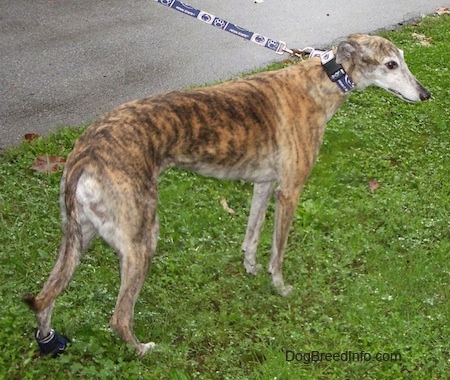
Nittany the Greyhound at 8 years old wearing her Penn State University leash, collar and boot.
Other Names
- English Greyhound
Pronunciation

Your browser does not support the audio tag.
Description
The Greyhound is a tall, slender dog. The head is long and narrow, wide between the ears, with a long tapering muzzle. There is no stop. The small rose ears are held back and folded, and are semi-perked when they are excited. The eyes are dark in color. The slightly arched neck is long. The legs are long with the front legs being perfectly straight. The chest is wide and deep. The long tail tapers with a slight upward curve. The short, fine coat comes in all colors.
Temperament
The Greyhound is brave and devoted. Intelligent, laid-back, charming and loving, its character is often undervalued because of its reserved behavior toward strangers and even its master. Greyhounds are sensitive to the tone of one's voice and will not listen if they sense that they are stronger minded than their owner, however they will also not respond well to harsh discipline. Owners need to be calm, yet possess an air of natural authority. Socialize well to prevent timidity. As a rule, they are gentle and even-tempered—both racing lines and show lines. Most Greyhounds have a definite prey drive. It is instinctive for these dogs to chase anything that moves quickly. They are extremely fast and some will kill cats and other domestic animals, although this is not the majority (only about 20% of ex-racers are too "keen" on chasing prey to ever be safe with small animals). About 10% are immediately okay due to low prey instinct, and the rest can be trained to leave cats and other small pets in the home alone. They seldom present difficulties with other dogs and are normally good with children, though they do not usually like roughhouse play, and would not be a good choice for young children who are looking for a playmate. Indoors, these dogs are calm and sociable to a point where they can even be considered lazy. They bond strongly with their own people, have tremendous stamina, and do not bark much. Show lines tend to be of a different body style than racing lines, and are often more angulated. Racing lines are bred for performance, but often a good by-product is that they are friendly, outgoing dogs that make wonderful pets when their racing days are over. Greyhounds are not particularly vigilant. Show lines tend to be a bit heavier and bred more for temperament than racing lines, which are bred for speed. However, racing lines also make wonderful pets. There are hundreds of adoption groups all over North America, Europe and Australia to place these gentle, loving dogs when they retire. Retired racing Greyhounds are not usually difficult to housebreak. They are already crate trained from the track, so it doesn't take them long to learn that they are not to "go" in the house. The Greyhound needs an even-tempered, gentle but firm loving owner who knows how to consistently communicate the rules of the home. A Greyhound that knows his place in his pack and what is expected of him is a happy Greyhound.
Height, Weight
Height: Males 28 - 30 inches (71 - 76 cm) Females 27 - 28 inches (68 - 71 cm)
Weight: Males 65 - 80 pounds (29 - 36 kg) Females 60 - 70 pounds (27- 31 kg)
Some lines are larger and have reached the 90-to-100 pound range (40 - 45 kg)
Health Problems
Prone to bloat. It is better to feed them 2 or 3 small meals rather than one large one. They are sensitive to drugs, including insecticides. It is said that they are also prone to hypothyroidism, however it is also believed that a Greyhounds' thyroid levels are naturally lower than most dogs and many people put them on unnecessary treatment for hypothyroidism - at much harm to the dog - upon recommendation from an uneducated vet. There is only one way to truly confirm if a greyhound actually has hypothyroidism, and that is to have a complete thyroid panel done (Michigan State University thyroid panel). There is an excellent book by Cynthia Branigan, "Adopting the Racing Greyhound", which has a whole chapter on it.
Living Conditions
The Greyhound will do okay in an apartment if it gets enough exercise. It is relatively inactive indoors and a small yard will do. Greyhounds are sensitive to the cold but do well in cold climates as long as they wear a coat outside. Do not let this dog off the leash unless in a safe area. They have a strong chase instinct and if they spot an animal such as a rabbit they just might take off. They are so fast you will not be able to catch them.
Greyhounds that are kept as pets should have regular opportunities to run free on open ground in a safe area, as well as daily long, brisk walks, where the dog is made to heel beside or behind the person holding the lead. In a dog's mind the leader leads the way and that leader needs to be the human. Greyhounds love a regular routine.
Life Expectancy
About 10-12 years.
Litter Size
Litter size varies greatly in this breed. From 1 to 12 puppies with the average of 8 born in one litter.
The smooth, shorthaired coat is very easy to groom. Simply comb and brush with a firm bristle brush, and dry shampoo only when necessary. This breed is an average shedder.
This very ancient breed is the fastest dog in the world and can reach speeds of over 40 miles per hour (65 km/h). Carvings of the Greyhound were found in tombs in Egypt dating back to 2900 B.C. They are thought to have originally descended from the Arabian Sloughi and brought to England by traders before 900 AD. The breed was first brought to America by the Spanish explorers in the 1500s. They were one of the first dogs ever to be shown in a dog show. The Greyhound’s natural quarry are the rabbit and hare, however it has also been used to hunt stag, deer, fox and wild boar. The dog’s speed along with its keen eyesight helped it excel at its work. The dogs were able to chase and catch the pray without stopping to rest. Today there are two types of Greyhounds being bred: Show lines, which conform to the written standard and racing lines, bred for speed. After retiring from a racing career, these dogs were often destroyed. With the dedicated efforts of Greyhound Rescue this practice has greatly reduced and the most mellow-tempered Greyhounds are found homes. The Greyhound was recognized by the AKC in 1885. The Greyhound’s talents include hunting, sighting, watchdog, racing, agility and lure coursing.
Southern, AKC Hound
Recognition
- CKC = Canadian Kennel Club
- FCI = FГ©dГ©ration Cynologique Internationale
- AKC = American Kennel Club
- UKC = United Kennel Club
- KCGB = Kennel Club of Great Britain
- CKC = Continental Kennel Club
- ANKC = Australian National Kennel Club
- NKC = National Kennel Club
- NZKC = New Zealand Kennel Club
- APRI = American Pet Registry, Inc.
- ACR = American Canine Registry
- DRA = Dog Registry of America, Inc.
- NAPR = North American Purebred Registry, Inc.
- ACA = American Canine Association Inc.
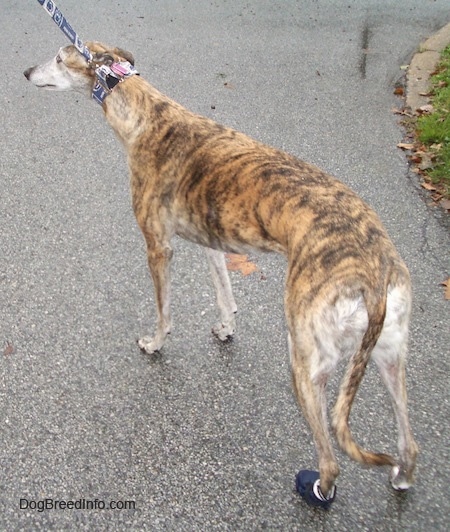
Nittany the Greyhound at 8 years old wearing her Penn State University leash, collar and boot.
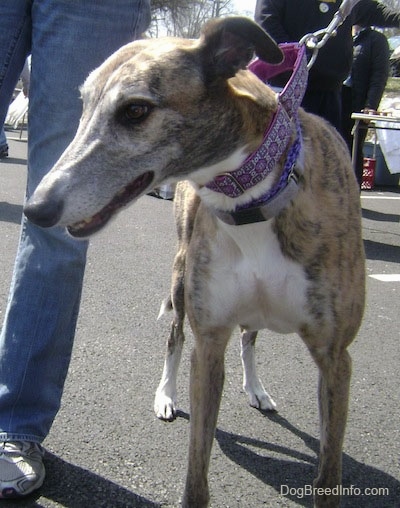
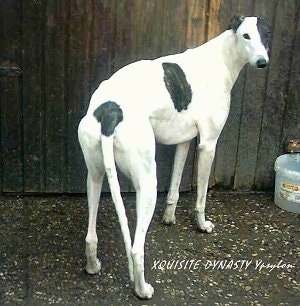
Xqisite Dynasty Ypsylon aka Lena, photo courtesy of Magda Kruszewska, Poland
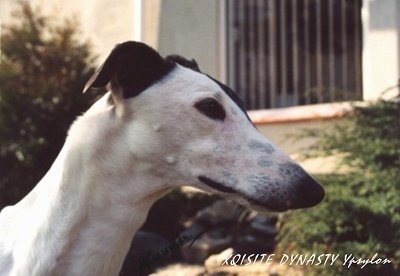
XQqisite Dynasty Ypsylon aka Lena, photo courtesy of Magda Kruszewska, Poland
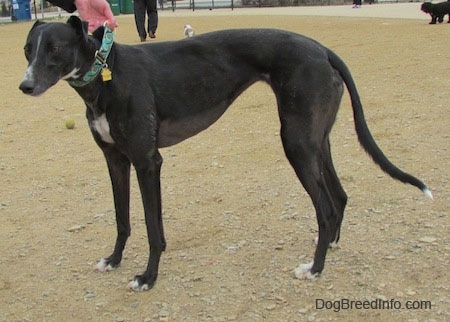
Snowy the Greyhound at 2 years old—"Snowy is a former race track dog. She was put up for adoption because she was not winning her races."
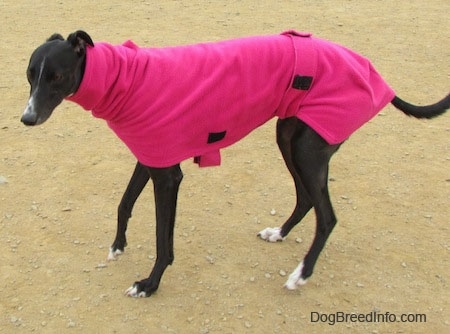
Snowy the Greyhound at 2 years old wearing her hot pink jacket
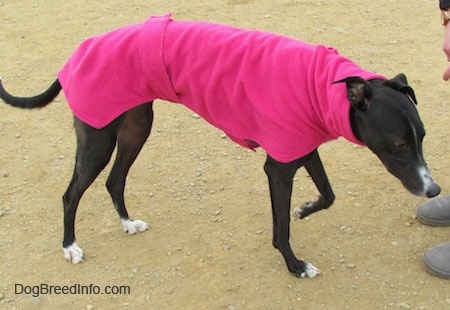
Snowy the Greyhound at 2 years old wearing her pink coat on a cold day
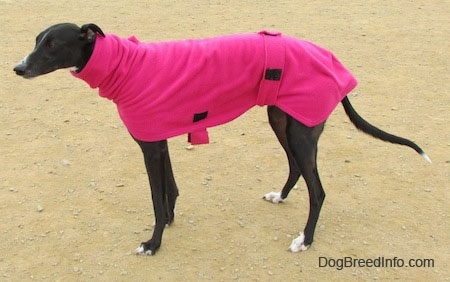
Snowy the Greyhound at 2 years old wearing her pink coat
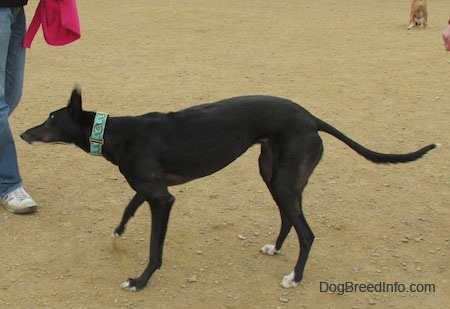
Snowy the Greyhound at 2 years old shaking off after her pink jacket was taken off
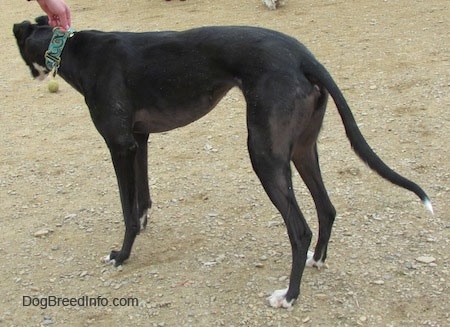
Snowy the Greyhound at 2 years old
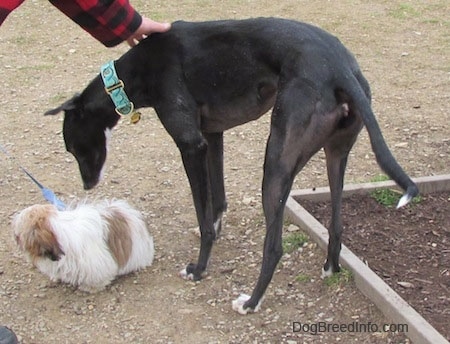
Snowy the Greyhound at 2 years old smelling Taina the Shih Tzu
Lexy the female purebred Greyhound at 3 years old. She was trained for racing, but never competed. She was adopted by her current owner from a racing dog rescue facility.
Lexy the female purebred Greyhound at 3 years old
Lexy the female purebred Greyhound at 3 years old
Lexy the female purebred Greyhound at 3 years old
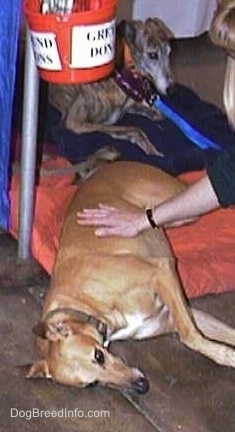
Adult Greyhound rescue dogs
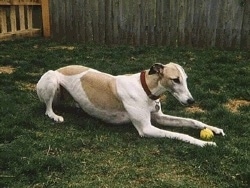
This is Bookie, an ex-racer. Bookie is now a therapy dog and has her CGC, TDI. She does nursing home visits, is very outgoing, and loves her new job. Photo courtesy of the Greyhound Rescue Society. Adopt a rescue Greyhound today and save a life.
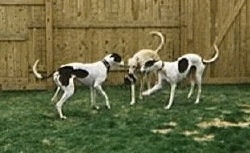
Enjoying some backyard play! Photo courtesy of the Greyhound Rescue Society
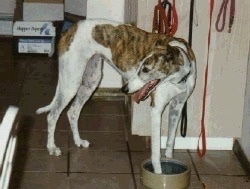
Dogs cool off through their feet and this Greyhound is attempting to cool off by stepping in her water bowl! Photo courtesy of the Greyhound Rescue Society
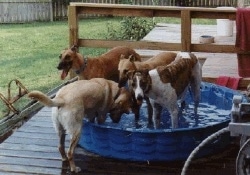
These Greyhounds are beating the summer heat. Photo courtesy of the Greyhound Rescue Society
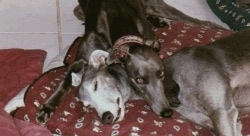
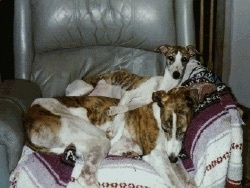
Indoors, Greyhounds are very calm, almost to the point where you could call them lazy. Photo courtesy of the Greyhound Rescue Society
Breeders
The Material contained herein may not be reproduced without the prior written approval of the author. Contents & Graphics Copyright © Dog Breed Info Center® (C) 1998- . All Rights Reserved. Our work is not Public Domain.
Swedish Vallhund
With their thick sable coat, sturdy construction, and overall no-frills look, Swedish Vallhunds are a timeless breed, as comfortable in a suburban backyard as they were on the prow of Viking longships 1,200 years ago. These lively herders are built long and low the ground—in not quite as exaggerated a fashion as their distant cousins the corgis, but the idea is the same: Their build makes it easier to nip at the heels of cattle and avoid kicks to the head. Balance, power, and a smooth movement are breed hallmarks.
- Dog Breeds
- Swedish Vallhund
- Personality: Sociable, cheerful, alert, and blessed with classic herding-dog intelligenc
- Energy Level: Very Active; Energetic and eager, but they settle down nicely for cuddle time
- Good with Children: Yes
- Good with other Dogs: With Supervision
- Shedding: Seasonal
- Grooming: Occasional
- Trainability: Eager To Please
- Height: 12.5-13.75 inches (male), 11.5-12.75 inches (female)
- Weight: 20-35 pounds
- Life Expectancy: 12-15 years
- Barking Level: Barks When Necessary
meet theSwedish Vallhund
Did you know?
The Swedish Vallhund is also known as Vastgotaspets and Swedish Cattledog.
How similar
Breed History
The Swedish Vallhund was officially recognized by the AKC.
Learn more about the Swedish Vallhund breed standard.
at aGlance
Energy & Size
AKC Dog Ranking
Personality
Energetic
Friendly
Watchful
NATIONAL BREED CLUB
theBreed Standard
Embed the breed standard on your site.
Download the complete breed standard or club flier PDFs.
Click the box above and use
Cmd + C or Ctrl + C
to add this code to your site/blog.
Adjust the height and width as necessary.
Show off your love for the Swedish Vallhund!
General Appearance
The Swedish Vallhund is a small, powerful, fearless, sturdily built Spitz herding dog. The correct relationship of height to length of body is 2:3. The SV has a wedge-shaped head, prick ears, and a close-fitting hard coat of medium length and sable coloring. The double coat and the characteristic "harness markings" are essential features of this breed. Tail may be natural (long, stub, or bob) or docked. The appearance of the Swedish Vallhund conveys intelligence, alertness and energy. Balance, outline, temperament and movement are of overriding importance.
Rather long and clean. Viewed from above, the head forms an even wedge from skull to tip of nose and is well filled-in under the eyes. Eyes - Medium size, oval in shape and dark brown with black eye rims. Ears - Medium size, pointed, prick. Set at the outer edge of the skull above a line drawn from the corner of the eye. Ear leather should be firm from base to tip, smooth-haired and mobile. The dog should make good use of them.
Neck - Long, strongly muscled with good reach. Topline - Level when standing or moving. Body - Chest - Good depth. The ribcage is long with fairly well sprung ribs. Viewed from the front, the chest should be oval; from the side, elliptical. In a mature dog it should reach down two-fifths of the length of the forelegs and, when viewed from the side, the lowest point of the chest is immediately behind the back part of the foreleg.
Forequarters
Shoulders - Strongly-muscled. Shoulder blades - Long and well laid back. Upper arms - Slightly shorter than the shoulder blades, set at an approximate 90 degree angle, close fitting to ribs, but still very mobile. A line perpendicular to the ground can be drawn from the tip of the shoulder blade through the elbow to the ground. Elbows - Move parallel to the body, turning neither in nor out. Forearms - When viewed from the front, slightly curved to give free action against the lower part of the chest; the pasterns and feet are parallel. Viewed from the side the forearms are straight. The height from ground to elbow is almost half the height from ground to withers. Legs - Well boned. Pasterns - Slightly sloping, elastic.
Medium length hair, harsh; topcoat close and tight. Undercoat is soft and dense. Hair is short on the head and the foreparts of the legs and slightly longer on neck, chest and back parts of the hind legs. Dogs are to be shown in an untrimmed, natural state. Faults include wooly, curly, or open coats. Fluffy coats (longer hair on body and furnishings, with ear fringes) are a serious fault.
Hindquarters
Angulation - To balance the front. Well angulated at stifle and hock. Legs - Well boned. Upper and lower thighs are strongly muscled. Lower thigh is slightly longer than the distance from hock to ground. Stifles - Well bent. Hocks (Metatarsal bones) - Perpendicular to the ground and viewed from the rear, parallel. Feet, toes and pads - Same as forefeet.
Swedish VallhundCare
Good nutrition for Swedish Vallhunds is very important from puppyhood to their senior years.
Their tight, medium-length coat is easy to groom and requires occasional brushing.
Very Active; Energetic and eager, but they settle down nicely for cuddle time.
Swedish Vallhunds are generally a healthy breed.
Bagle Hound
Basset Hound / Beagle Mixed Breed Dogs
Information and Pictures
Leo the Bagle Hound (Basset Hound / Beagle mix) at 6 years old
Description
The Bagle Hound is not a purebred dog. It is a cross between the Basset Hound and the Beagle. The best way to determine the temperament of a mixed breed is to look up all breeds in the cross and know you can get any combination of any of the characteristics found in either breed. Not all of these designer hybrid dogs being bred are 50% purebred to 50% purebred. It is very common for breeders to breed multi-generation crosses.
Recognition
- ACHC = American Canine Hybrid Club
- DBR = Designer Breed Registry
- DDKC = Designer Dogs Kennel Club
- DRA = Dog Registry of America, Inc.
- IDCR = International Designer Canine Registry ®
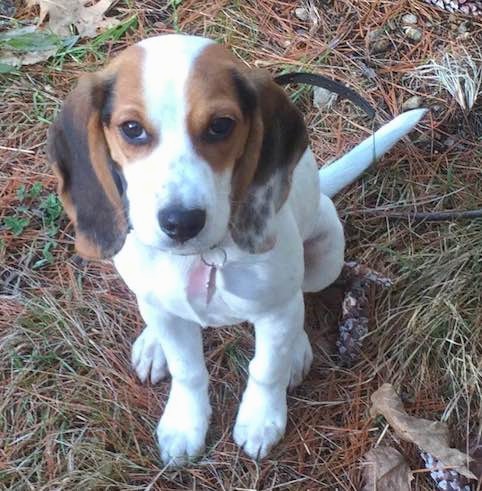
Arlo the Bagle Hound at 4 months old—"Arlo has been an amazing puppy so far and I can't wait to see what the future holds with him. He is really sweet, has his moments of being pretty hyper and loves exploring. He also loves to climb. He is very, very social, loves people and other animals, and is very affectionate towards kids. I will say this pup was easier to train then we were expecting with the stories of Beagles being stubborn. He is stubborn but picks up things really fast. He is also incredibly smart."
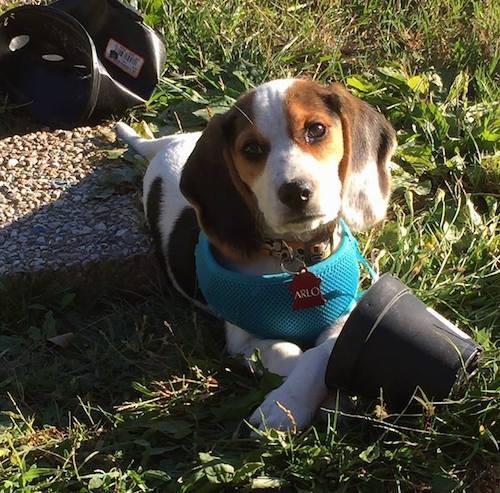
Arlo the Bagle Hound at 4 months old
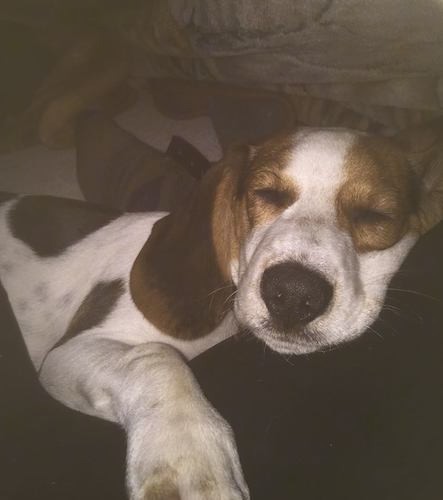
Arlo the Bagle Hound at 4 months old
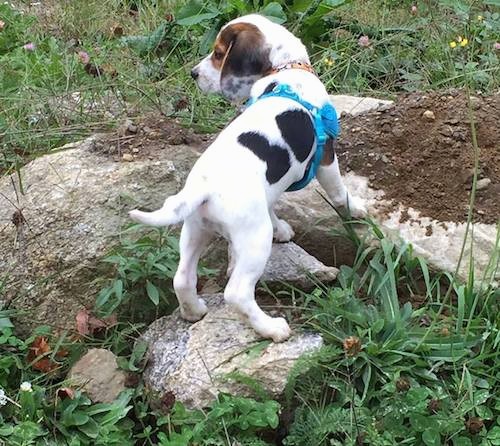
Arlo the Bagle Hound at 4 months old
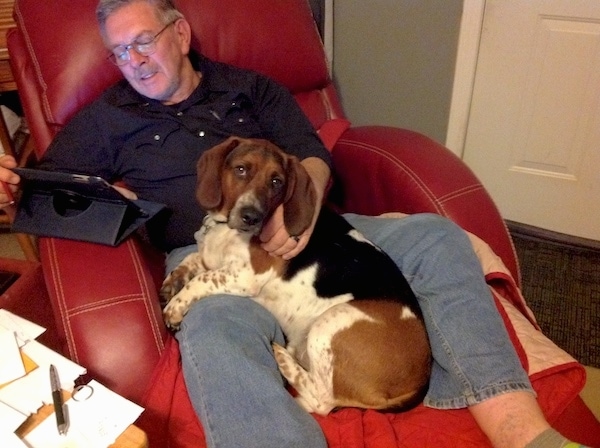
"A friend found a pregnant Basset Hound and took her to a Basset rescue. We all agreed to take the pups which were half Beagle. I got Buster as a gift for my husband. My husband is a diabetic and as his disease progressed Buster's sense of smell increased. If there's a change in my husband's chemistry Buster will sense it and notify my husband. If my husband passes out Buster will nudge and pull on him to wake him and get him to check his sugar. If he's sick he stays right with him. Buster is an awesome dog who retains the hound characteristics of walking nose down, sniffing the air and chasing rabbits and letting loose a big bark!"
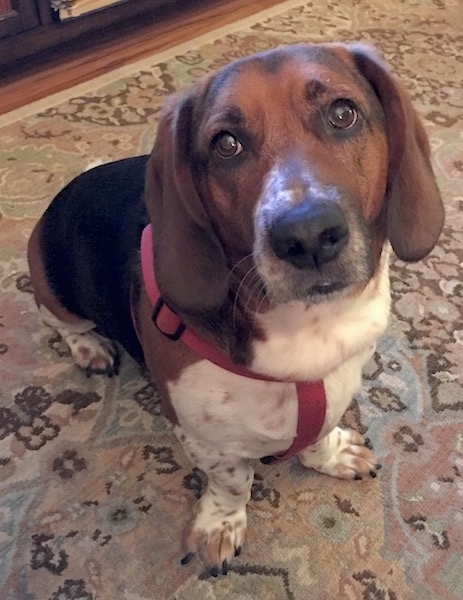
Buster the Bagle Hound at 5 1/2 years old
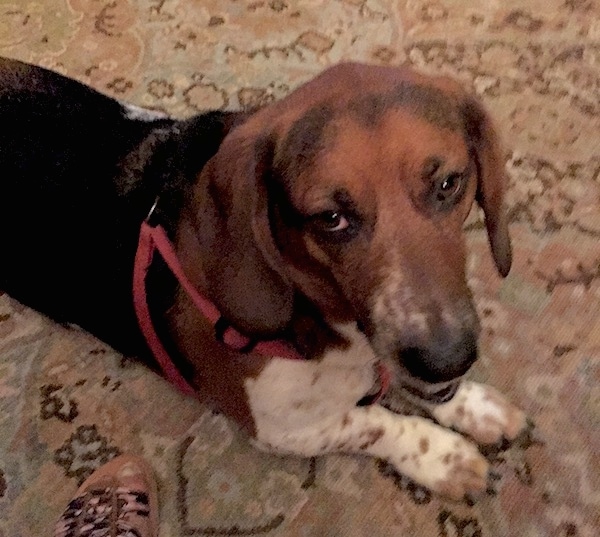
Buster the Bagle Hound at 5 1/2 years old
"This is my little Bagle, Zo-Wee, a Beagle and Basset Hound mix. Zo-Wee has more personality than some people I know. This picture shows her at 6 years old. Her colors aren't as pronounced in her face as they were when she was younger. She weighs 28 pounds and has bursts of boundless energy followed by hours of snoozing. She talks about everything and sometimes wears a citronella collar because her enthusiasm can be a bit loud. Throughout her life she's had excellent health, but like Basset Hounds, requires frequent ear cleaning. She's the sweetest dog I've ever known!"
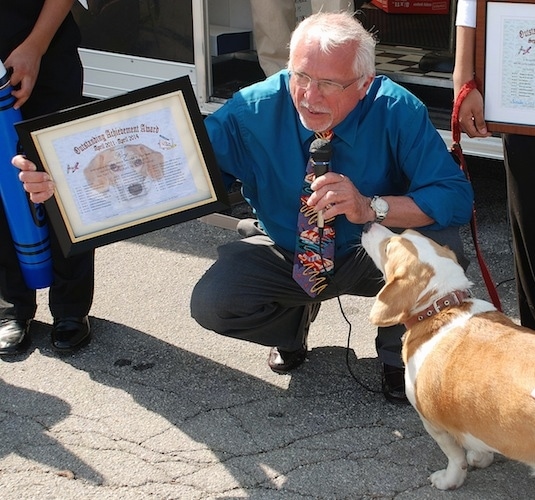
Roy the Bagle (Beagle / Basset Hound mix)—"Roy (a.k.a. No Brainer; Jumbo Frank; Low Rider and Limo [because he's stretched]) is a Cinderella story. This is Roy receiving his Outstanding Achievement Award for attending THIRTY car shows between April, 2011 and April, 2014. The presentation took place at the Horseless Carriage Club of Missouri's 53rd Annual Concours d'Elegance in Forest Park. He was a rescue dog from the Monroe County Humane Society and had been part of an adoption event held at a car show in Columbia, IL. His name was Rory, but my wife had a hard time with the second R so she just called him Roy. He soon took on some appropriate nicknames and has been our mascot for the Take A Kid To A Car Show program started many years ago by SEMA, the Specialty Equipment Market Association in Diamond Bar, CA. The ladies say he is "beautiful" and he sometimes wears an infant T that bears the message "I'm a Chick Magnet". In the past four years, Roy has been to over 40 car shows with my foster grandsons and me. In typical basset manner, he is a lover boy all the way. extremely affectionate and gentle. He loves everyone, especially children. I like to say his two favorite things are cheeseburgers and children."
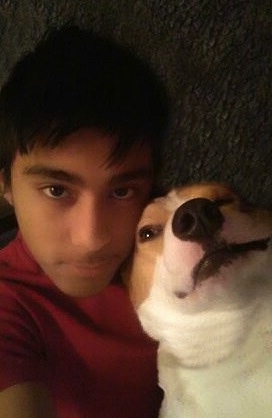
Roy the Bagle (Beagle / Basset Hound mix)—"TKCS volunteer and foster grandson Luis Hernandez takes a selfie with Roy. One of my all time favorite pictures. It reminds me of the famous quote by Josh Billings, "A dog is the only thing that loves you more than he loves himself".
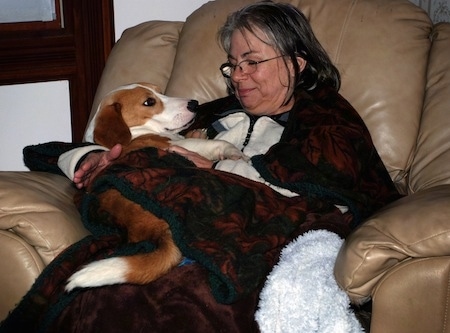
Roy the Bagle (Beagle / Basset Hound mix)— "Mamma was feeling a bit under the weather, but Roy's loving ways put a smile on her face."
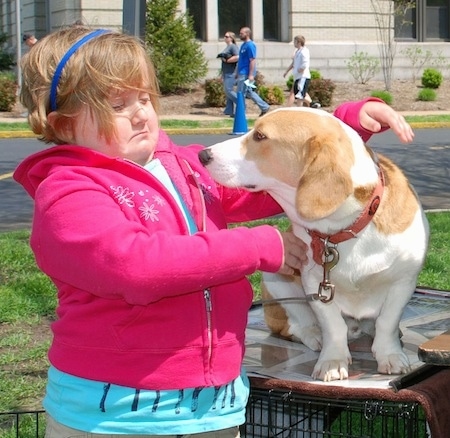
Roy the Bagle (Beagle / Basset Hound mix)— "Roy's first car show at Ranken Technical College, April 17, 2011. Getting to know Roy is Olivia."
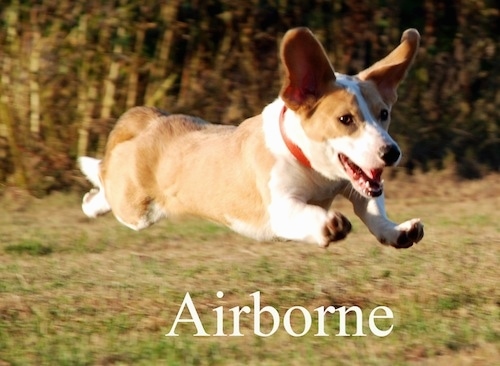
Roy the Bagle (Beagle / Basset Hound mix) airborn!—"First day at home and isn't he the picture of happiness!"
Breeders
The Material contained herein may not be reproduced without the prior written approval of the author. Contents & Graphics Copyright © Dog Breed Info Center® (C) 1998- . All Rights Reserved. Our work is not Public Domain.



Комментариев нет:
Отправить комментарий